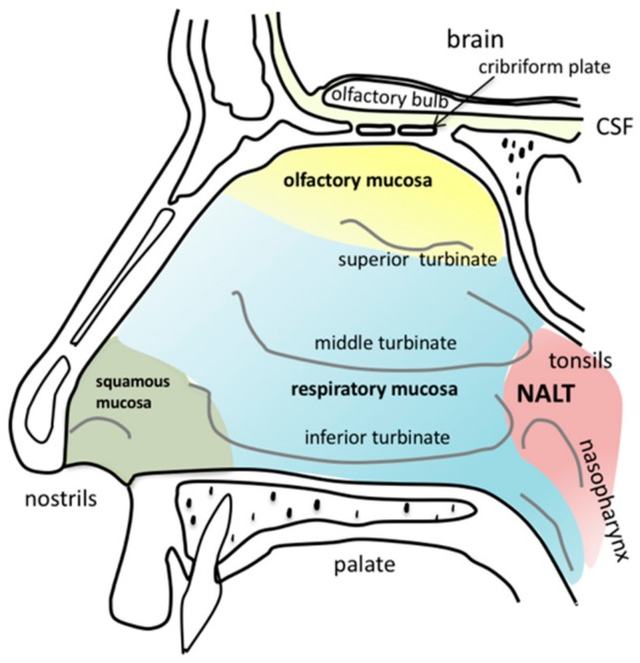Loading AI tools
Large, air-filled space above and behind the nose in the middle of the face From Wikipedia, the free encyclopedia
The nasal cavity is a large, air-filled space above and behind the nose in the middle of the face. The nasal septum divides the cavity into two cavities,[1] also known as fossae.[2] Each cavity is the continuation of one of the two nostrils. The nasal cavity is the uppermost part of the respiratory system and provides the nasal passage for inhaled air from the nostrils to the nasopharynx and rest of the respiratory tract.
The paranasal sinuses surround and drain into the nasal cavity.

The term "nasal cavity" can refer to each of the two cavities of the nose, or to the two sides combined.

The lateral wall of each nasal cavity mainly consists of the maxilla. However, there is a deficiency that is compensated for by the perpendicular plate of the palatine bone, the medial pterygoid plate, the labyrinth of ethmoid and the inferior concha. The paranasal sinuses are connected to the nasal cavity through small orifices called ostia. Most of these ostia communicate with the nose through the lateral nasal wall, via a semi-lunar depression in it known as the semilunar hiatus. The hiatus is bound laterally by a projection known as the uncinate process. This region is called the ostiomeatal complex.[3]
The roof of each nasal cavity is formed in its upper third to one half by the nasal bone and more inferiorly by the junctions of the upper lateral cartilage and nasal septum. Connective tissue and skin cover the bony and cartilaginous components of the nasal dorsum.
The floor of the nasal cavities, which also form the roof of the mouth, is made up by the bones of the hard palate: the horizontal plate of the palatine bone posteriorly and the palatine process of the maxilla anteriorly. The most anterior part of the nasal cavity is the nasal vestibule.[4] The vestibule is enclosed by the nasal cartilages and lined by the same epithelium of the skin (stratified squamous, keratinized). Within the vestibule, this changes into the typical respiratory epithelium that lines the rest of the nasal cavity and respiratory tract. Inside the nostrils of the vestibule are the nasal hair, which filter dust and other matter that are breathed in. The back of the cavity blends, via the choanae, into the nasopharynx.
The nasal cavity is divided in two by the vertical nasal septum. On the side of each nasal cavity are three horizontal outgrowths called nasal conchae (singular "concha") or turbinates. These turbinates disrupt the airflow, directing air toward the olfactory epithelium on the surface of the turbinates and the septum. The vomeronasal organ is located at the back of the septum and has a role in pheromone detection.
The nasal cavity has a nasal valve area that includes an external nasal valve and an internal nasal valve. The external nasal valve is bounded medially by the columella, laterally by the lateral nasal cartilage, and posteriorly by the nasal sill.[5] The internal nasal valve is bounded laterally by the caudal border of the lateral nasal cartilage, medially by the dorsal nasal septum, and inferiorly by the anterior border of the inferior turbinate.[6] The internal nasal valve is the narrowest region of the nasal cavity and is the primary site of nasal resistance.[7]
The nasal cavity is divided into two segments: the respiratory segment and the olfactory segment.
There is a rich blood supply to the nasal cavity. Blood supply comes from branches of both the internal and external carotid artery, including branches of the facial artery and maxillary artery. The named arteries of the nose are:
Innervation of the nasal cavity responsible for the sense of smell is via the olfactory nerve, which sends microscopic fibers from the olfactory bulb through the cribriform plate to reach the top of the nasal cavity.
General sensory innervation is by branches of the trigeminal nerve (V1 and V2):
The nasal cavity is innervated by autonomic fibers. Sympathetic innervation to the blood vessels of the mucosa causes them to constrict, while the control of secretion by the mucous glands is carried on postganglionic parasympathetic nerve fibers originating from the facial nerve.
The two nasal cavities condition the air to be received by the other areas of the respiratory tract. Owing to the large surface area provided by the nasal conchae (also known as turbinates), the air passing through the nasal cavity is warmed or cooled to within 1 degree of body temperature. In addition, the air is humidified, and dust and other particulate matter is removed by nasal hair in the nostrils. The entire mucosa of the nasal cavity is covered by a blanket of mucus, which lies superficial to the microscopic cilia and also filters inspired air. The cilia of the respiratory epithelium move the secreted mucus and particulate matter posteriorly towards the pharynx where it passes into the esophagus and is digested in the stomach. The nasal cavity also houses the sense of smell and contributes greatly to taste sensation through its posterior communication with the mouth via the choanae.
This section needs expansion. You can help by adding to it. (February 2011) |
Diseases of the nasal cavity include viral, bacterial and fungal infections, nasal cavity tumors, both benign and much more often malignant, as well as inflammations of the nasal mucosa. Many problems can affect the nose, including:
Seamless Wikipedia browsing. On steroids.
Every time you click a link to Wikipedia, Wiktionary or Wikiquote in your browser's search results, it will show the modern Wikiwand interface.
Wikiwand extension is a five stars, simple, with minimum permission required to keep your browsing private, safe and transparent.